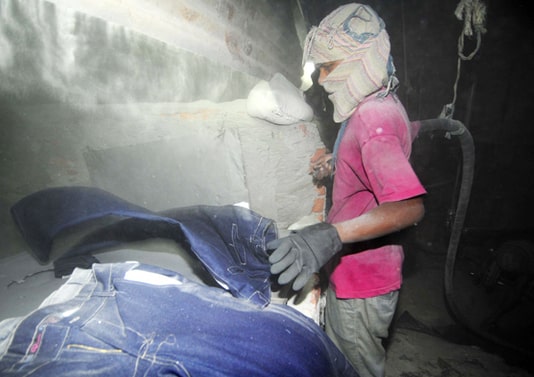Sandblasting Process on Denim:
Sandblasting is a process by which the denim (jeans) surface is abraded using sand containing silica. This process imparts a ‘worn-out’ look to the denim.
Sandblasting is a modern technique applied to the specific portions of the indigo-dyed denim apparel using special types of sands that do not cause problems associated with stone washing. The sandblast fading process is popular in the industry for achieving a worn vintage effect in denim fabric.

Sandblasting involves blasting an abrasive material in a granular, powdered or other form through a nozzle at very high speed and pressure onto specific areas of the garment’s surface to give a desired distressed, abraded and used look.
As the name implies, sandblasting creates light wash denim patterns by blasting areas of the fabric with sand or other abrasive materials at high velocity. The result is a subtle fade across the front and back of the pants leg.
Sandblasting is a mechanical process that creates localized abrasion or color changes on the denim garment. The process involves blasting an abrasive material in granular, powdered form at a very high speed and pressure through a nozzle onto certain areas of the garment such as knees and elbows. The garment treated surface results in a distressed, abraded and used look. Common blasting materials used are sand and metal granules.
Before sandblasting the garment is first subjected to a stone wash to the desired degree of washing. It is then sandblasted.
A solution of sodium hypochlorite or PP is often sprayed in the desired area of the garment to obtain the same look. The garment is then neutralized, rinsed, softened and dried. Sandblasting is a water-free process; therefore no drying is required.
Health Hazards of Sandblasting:
Sandblasting is a mechanical finish which uses sand containing silica. The minute silica dust spreads in air and poses serious respiratory disease such as silicosis. Sandblasting removes dark indigo pigmentation from a garment that is usually made of denim, giving it a popular preworn look. The process involves smoothing, shaping and cleaning a hard surface by forcing abrasive particles across that surface at high speeds using special types of sands. These are sprayed onto selected parts of the garments at high pressures through air compressors to remove color from the areas to create the desired design.
You may also like: Step by Step Bleach Wash Process in Garments
Sandblasting may be of two types: manual and mechanical. In manual sandblasting, compressors are used to blow out sand under pressure through a gun to strike the denim fabric. This process is done in the absence of sealed blasting cabinets and ventilation, exposing operators directly to silica particles (tiny particles of blasted sand) that are released from the guns. If inhaled, this silica dust can cause severe respiratory problems in workers. In cases of intense or long-term exposure, it may even lead to the contraction of fatal diseases such as silicosis and lung cancer. Although the most common form of sandblasting is manual blasting, sandblasting can also be performed mechanically in blasting cabinets where the process is supposed to be more controlled. It was the high health risks associated with manual sand blasting process that prompted regulation of the technique in the Europe in the 1960s. Sand blasting can expose workers to extreme health hazards and can cause death within months or years of starting work as a sandblaster.
Sand blasting can cause breathing problems, coughing, sneezing, and other such problems in the short run. It can also cause weight loss and weakness. If exposed to such a working condition for long, it can cause fatal diseases including Silicosis and other incurable lung diseases. It can also lead to lung cancer.
Sandblasting using natural sand is especially problematic because workers inhale crystalline silica dust particles during production, causing serious damage to the respiratory passages. These particles are so tiny that they are invisible to the naked eye. The body is unable to expel the silica particles, causing diseases such as silicosis. The particles penetrate the pulmonary alveoli and the connective tissue, gradually impairing lung capacity and the workers’ ability to oxygenate blood. Symptoms include shortness of breath; as the disease develops, this is common even when resting. This puts additional strain on the heart, eventually leading to death. However, the progress of silicosis can be slowed if symptoms are diagnosed at an early stage.
However the report showed that mechanical sandblasting as done in Bangladesh actually continues to expose workers to silica dust. The research showed that mechanical sandblasting is largely carried out in unsealed environments with little protection for workers, who are provided with inadequate safety equipment. As a result, the use of this technique continues to expose workers to a potentially fatal risk.
After the imposition of strict regulations on sandblasting in many European countries, the clothing industry has largely outsourced production to as yet unregulated regions such as Turkey, Bangladesh and China.
References:
- Denim: Manufacture, Finishing and Applications Edited by Roshan Paul
- Sustainability in Denim Edited by Subramanian Senthilkannan Muthu
- Handbook of Value Addition Processes for Fabrics By B. Purushothama
You may also like: Acid Washing Process of Denim Jeans
